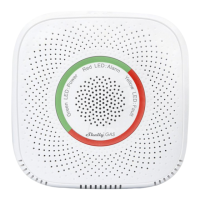
Do you have a question about the Shelly GAS and is the answer not in the manual?
| Alarm Sound Level | 85 dB |
|---|---|
| Valve Control | Yes |
| Radio Signal Power | 1mW |
| Type | Gas Detector |
| Gas | LPG |
| Wi-Fi | Yes |
| Operating Temperature | -10°C to +50°C |
| Operational Range | Up to 50 m outdoors and up to 30 m indoors |
| Power Consumption | < 1.5 W |
| Output | Relay NO/NC |
| Humidity Range | 10% to 90% RH |
Details electrical requirements, radio protocols like WiFi, and signal power.
Lists directives and standards the device adheres to for market access.
Covers detected gas types, operating temperature, range, and alarm sound.
Provides physical size specifications and power usage details.
Describes LED behavior in STA and AP modes for connection status.
Details audible alerts for device warm-up, faults, self-tests, and gas leaks.
Crucial warnings regarding proper installation, power grid use, and handling.
Recommendations for optimal placement and the initial device self-test sequence.
Instructions to restore the device to its original factory default settings.
Overview of Shelly as a brand for remote home control devices.
Information on compatibility with voice assistants like Alexa and Google.
Details the Shelly Cloud app's purpose and how to install it from app stores.
Guides on creating an account to manage Shelly devices via the mobile app.
Steps to recover a lost password for the Shelly Cloud account.
Explains the expected Wi-Fi LED behavior during the inclusion process.
Instructions on connecting your phone/tablet to the device's Wi-Fi network.
Selecting discovered devices, setting names, rooms, and pictures.
Steps to activate remote control and monitoring via Shelly Cloud service.
Overview of managing and automating devices within the Shelly app.
How to perform a self-test and mute active alarms on the device.
Configuring Wi-Fi modes, backup, and restricting login access.
Adjusting alarm volume, time zone, and accessing device information.
How to change the device name, assign it to a room, or update its picture.
Instructions on how to access the device's web UI via a browser.
Details the information displayed on the device's main web page.
Covers Wi-Fi modes, login restrictions, and SNTP server settings.
Explores developer settings, cloud connection, and time zone configuration.
Procedures for updating firmware and restarting the device.
Accessing device ID, Wi-Fi name, and signal strength.
Understanding control via HTTP, REST protocol, and developer contacts.